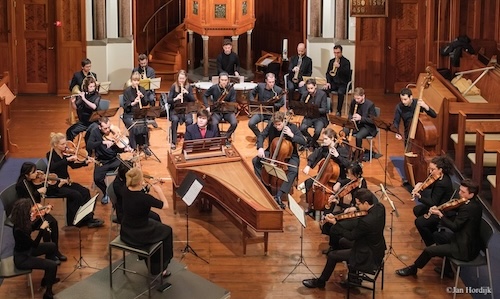Das Neue Mannheimer Orchester
 A thundering waterfall! A crystal-clear stream murmuring in the distance… A sweet spring breeze: Such captivating and powerful acoustic images characterized the performances of the Mannheim Court Orchestra during its golden era from 1742-78.
A thundering waterfall! A crystal-clear stream murmuring in the distance… A sweet spring breeze: Such captivating and powerful acoustic images characterized the performances of the Mannheim Court Orchestra during its golden era from 1742-78.
Revered as one of the finest musical institutions of that time in all of Europe, the revolutionary style of the composers working for this orchestra, combined with impressive performances, inspired a new musical generation, including W.A. Mozart. Unfortunately, the music of the Mannheim School is underestimated today and is heard far too rarely in concerts.
Inspired by this wonderful model, The New Mannheim Orchestra strives to change that!
And the young instrumentalists led by their conductor, the keyboard virtuoso Anders Muskens, aim not only to revive the music of their predecessor ensemble and that of the Classical and Romantic eras but also its spirit. They are convinced that this music still has the power to evoke strong, sublime—almost supernatural—emotions in their audience today, but, of course, only when performed in a manner faithful to its historical context.
Thus, using historically informed performance practices and authentic instruments, but also through a fresh interpretation emphasizing vibrant expression, they intend to lead their audience to the highest enthusiasm and create unforgettable emotional experiences for modern listeners.
In short: They want to prove that 18th-century music is far from outdated today and that the Mannheim style was truly the «Hard Rock» of its era!
SONUS about Das Neue Mannheimer Orchester:
What always comes to mind first when considering this predominantly young ensemble is: They play so light, so elastic, and so vital that as a listener, you can't help but feel in a good mood!
This is primarily due to the fantastic transparency that the musicians create, even in denser passages, by playing exceptionally homogeneously within their sections, setting very deliberate tension lines, making even inner voices audible when they have something important to say. This works remarkably well even with larger ensembles, which then seem almost chamber-musical but with considerable aplomb.
And the good mood even applies to slow minor-key movements (which, although it may go against the intention of some composers, deserves mention!).
It's almost unnecessary to mention that with the DNMO, one can always enjoy exquisite intonation, the ensemble playing is top-notch, and the music is intellectually and emotionally deeply understood; a gratifying side effect when the conductor not only performs but also engages in scholarly work. Finally, the musicians' great joy in playing contributes to this good-mood result: Watching them make music together, observing how they communicate on stage, spur each other on, challenge each other, but also admire and encourage each other, you simply become part of this enthusiastic community as a concertgoer.
In short: The performances of this ensemble are indeed something special in today's world of Baroque orchestras, and the musicians persist in their efforts to keep it that way!
Sound samples
Niccolo Jomelli: Aria from Arcadia Conservata: »D'un van timore, d'un can timore il freno«
Johann Stamitz: Sinfonie A major, WolS I, 1st movement
Anton Fils: Sinfonie No.8 in G major
Allegro assai
Please also visit Das Neue Mannheimer Orchester on our YouTube channel!
